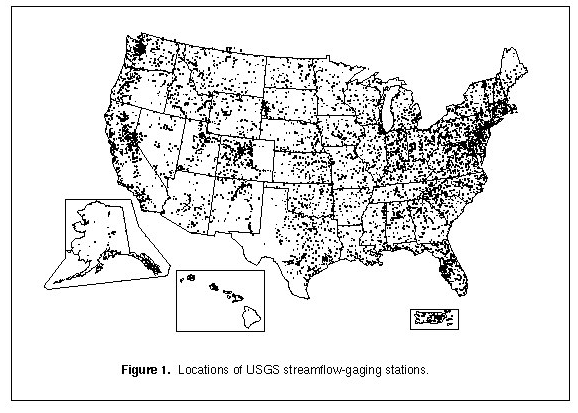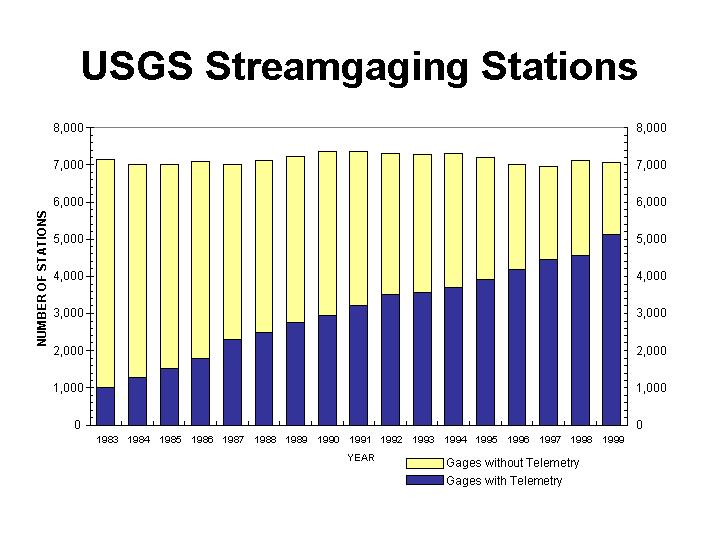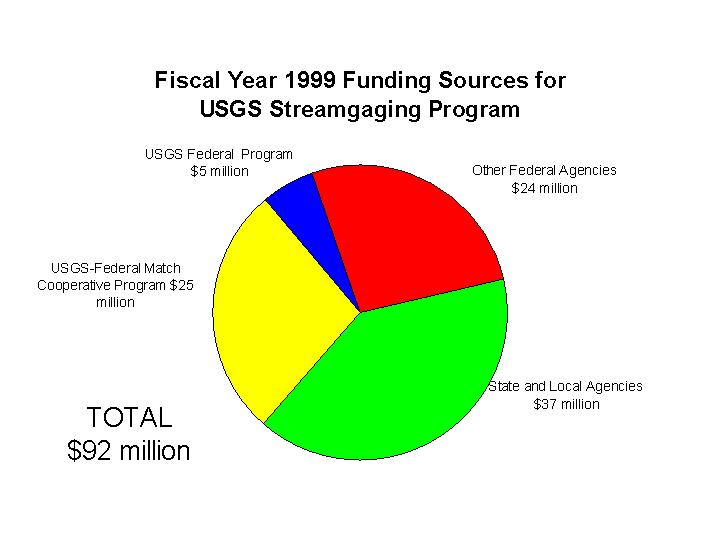
Over time, the USGS streamflow-gaging network (fig. 1) has changed as new needs for streamflow data have emerged and new technologies for data collection, analysis, and dissemination have evolved. In recent years, the USGS has focused on adapting new communications technologies to serve water-resource managers better, developing more efficient data-collection technologies, and expanding partnerships with other Federal, State, and local agencies.

Throughout the country, USGS stations equipped with real-time telemetry are integral components of reservoir operations and river-forecast and flood-warning systems. About 4,200 stations, which total 60 percent of the USGS network, are equipped with automated Data Collection Platforms (DCP's) that use satellite radio transmitters to broadcast stream-stage data 24 hours a day directly to major cooperators, such as the National Weather Service (NWS), the U.S. Army Corps of Engineers, and the Bureau of Reclamation. These and other Federal, State, and local agencies use the river-stage data to forecast river conditions, to issue flood warnings and river-conditions statements, and to plan reservoir releases or water withdrawals. So important are telemetered data to the missions of these agencies that the number of stations equipped with DCP's is steadily being increased even as the overall streamflow-gaging network is being reduced (fig. 2).

In addition to near-real-time data, the USGS also provides historical daily streamflow data on the WWW. Daily data for more than 19,000 locations are available. The on-line availability of the USGS data enables users to perform more easily hydraulic and hydrologic analyses that are essential to the planning, design, and operation of water-resources projects. At the same time, serving the data through the WWW has greatly reduced the number of data requests that the USGS previously processed manually.
The NSP fulfills many purposes -- water resources planning and flood mitigation, design of water storage and treatment facilities, water management and reservoir operations, water quality control, and flood forecasting. Balancing the priorities of gages to meet these purposes is driven by market forces as Federal, State, and local agencies, as well as USGS, contribute to the program based on their need for data for long-term planning or day-to-day operations. State agencies such as natural resource and transportation departments typically need data for planning and design. Other agencies such as water supply or pollution control departments at the State and local level need data for managing daily withdrawals and levels of treatment. Federal agencies, particularly the Corps of Engineers, traditionally have supported streamgaging stations for both planning and design and day-to-day operations.
The market system assures a high degree of effectiveness and relevance for the NSP, but it has an imperfection related to an under-investment in some national benefits to the program which the USGS is primarily responsible for providing. These include stations that are used primarily as indices of climate and streamflow variability and those used for flood warning. The index stations provide long-term background information on how streamflow (floods, droughts, average flows) changes over long periods of time in response to forces such as land-use change, long-term climate variability (e.g., El Nino), and long-term climate change (e.g., due to greenhouse warming). As State and Federal budgets have become constrained, funds from the supporting agencies have been directed to support current purpose stations instead of index stations. Also, flood warning stations lack a constituency for a couple of reasons. The first is that hazard warning information is generally thought of as a Federal function and States and localities are not accustomed to paying for it. For example, information on severe storms (tornado or hurricane), earthquakes, volcanic eruptions are all funded by Federal money. Thus, emergency management agencies are not accustomed to budgeting for the data-collection and data-dissemination functions. Also, because of technological changes in the last couple of decades (satellite data transmission, doppler radar for precipitation estimates and improvements in flood forecast models), the USGS streamflow data are now much more valuable from a hazard warning perspective than they were in the past. However, no agency's budget (NWS, USGS, FEMA, or State or local agencies) have been enhanced to take advantage of this real-time benefit.
The USGS uses its appropriations to support the parts of the NSP that the market-driven mechanism under-invests in. However, our ability to balance the system is limited because of the distribution of funds for the program. In 1997, the funding for the NSP was $85 million; USGS appropriations were $28 million; contributions of other Federal agencies were $25 million; and contributions from State and local agencies were $32 million (fig. 3). The USGS appropriations include $5 million from the Hydrologic Networks and Analysis Program and $23 million from the Federal-State Cooperative Water Program. By law, the $23 million in Cooperative Program funds must be matched with at least an equal contribution from State and local agencies.

The third element of the NSP funding base is the funds provided by other Federal agencies and unmatched funds from State and local agencies. The stations supported by the $25 million contributed from other Federal agencies are also important components of the flood forecasting network. Although these stations provide data for a specific operational purpose, many of them are used by the NWS for flood forecasting. Some of the stations supported by the $9 million of unmatched funds from State and local agencies also support the flood forecasting network. These are stations that are used by State or local agency for an operational purpose, but are also used by the NWS as model control points. They are not supported by Federal Coop funds because there are insufficient funds to support all the stations that provide data of national interest.
USGS Fact Sheet FS-209-95, Stream Gaging and Flood Forecasting, A partnership of the U.S. Geological Survey and the National Weather Service (By Robert R. Mason, Jr., USGS, and Benjamin A. Weiger, NWS)
USGS Fact Sheet FS-006-97, Streamflow Information for the Nation (By Robert R. Mason, Jr. and Thomas H. Yorke, USGS)
|
U.S. Department of the Interior, U.S. Geological Survey
Maintainer: Office of Surface Water Last update: 15:02:17 Thu 20 Mar 2003 Privacy Statement || Disclaimer || Accessibility URL: http://water.usgs.gov/nsip/streamgaging.html |

|